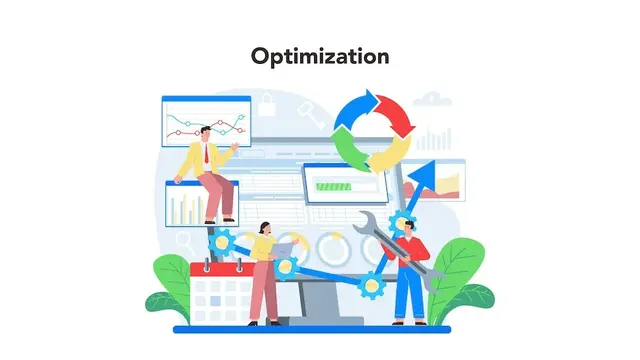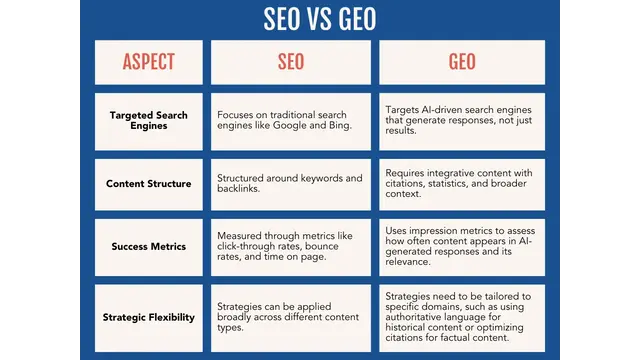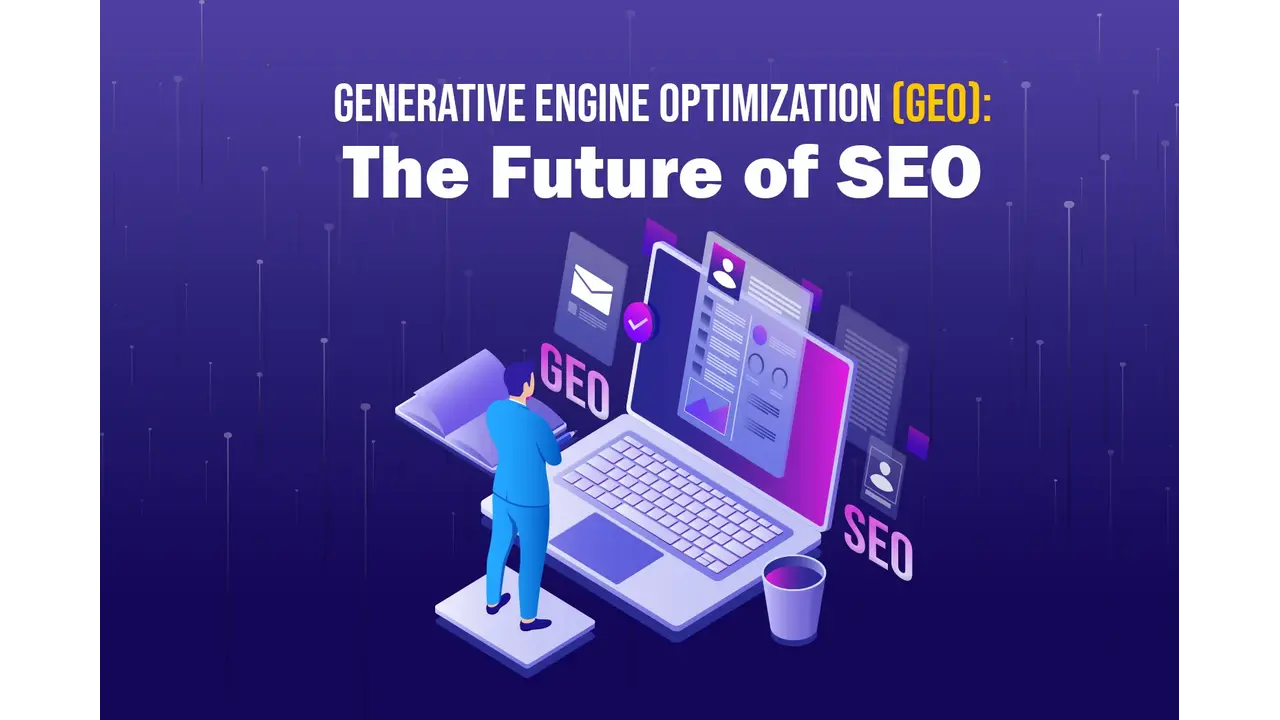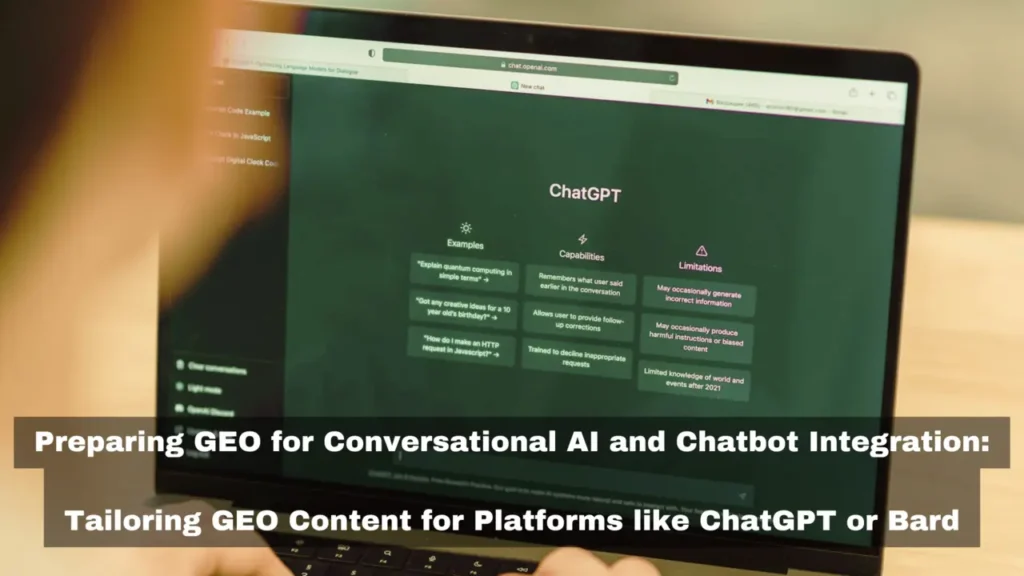As artificial intelligence (AI) continues to evolve, it is rapidly transforming industries worldwide. One of the most significant shifts can be seen in search engine optimization (SEO) with the advent of Generative Engine Optimization (GEO). This innovative approach leverages AI and machine learning to automate and enhance SEO, enabling SEO professionals to scale efforts, align content with user intent, and adapt dynamically to ever-changing algorithms. For businesses looking to implement advanced SEO strategies, explore resources like Wodo’s comprehensive digital solutions here. This article explores what GEO is, how it works, why it matters, and what the future of SEO holds with this groundbreaking technology.
Key Takeaways
- Generative Engine Optimization (GEO) uses AI to automate and enhance SEO tasks, creating user-intent-focused and algorithm-friendly content.
- Core Technologies: GEO is powered by advanced language models (GPT, BERT, T5), neural networks, and NLP, allowing for human-like, context-aware content generation.
- Efficiency and Scalability: GEO increases productivity by automating content creation, on-page optimization, and trend adaptation, making it highly scalable.
- Ethical and Quality Considerations: GEO requires ethical oversight, addressing AI bias, ensuring transparency, and balancing automation with quality control.
- Applications and Future Trends: GEO is widely applicable in e-commerce, SaaS, and service-based businesses, with future developments likely to focus on visual and voice search optimization.
Table of Contents
What is Generative Engine Optimization?
Definition of Generative Engine Optimization (GEO)
Generative Engine Optimization (GEO) is the practice of using AI, particularly generative language models, to automate and optimize SEO tasks. Traditional SEO relies heavily on manual processes, from keyword research and content creation to technical SEO and on-page optimization. In contrast, GEO leverages machine learning to generate, refine, and update content, making it more relevant to user queries and more aligned with search engine algorithms.
Key Elements of GEO
- Automation: GEO automates many aspects of SEO, from content creation to on-page optimizations, freeing SEO professionals to focus on strategy.
- User Intent Matching: By analyzing user behavior, GEO models tailor content to specific search intents, making content more relevant.
- Real-Time Adaptation: As algorithms and user behavior shift, GEO can adapt content in real-time, ensuring ongoing relevance.
Benefits of GEO
- Speed and Efficiency: GEO processes tasks at a fraction of the time required by manual SEO methods, significantly boosting productivity.
- Personalization: Using data-driven insights, GEO can personalize content, providing users with highly targeted and relevant information.
- Scalability: Automating routine SEO tasks allows websites of any size to meet SEO requirements without needing extensive resources.
Why GEO Matters in Today’s SEO Landscape
As search engines like Google continue to integrate AI-driven algorithms, traditional SEO methods can struggle to keep up. GEO not only meets evolving algorithm requirements but also enhances user experience by creating highly relevant, intent-driven content. With AI continuously learning from data, GEO can adjust dynamically, making it a vital tool in staying competitive.

How Generative Engine Optimization Works
Key Components of GEO
To understand how GEO functions, it’s essential to know its core components. These include advanced language models, neural networks, and natural language processing (NLP). Let’s look at each one in detail.
Advanced Language Models
GEO relies on language models like GPT (Generative Pre-trained Transformer), BERT (Bidirectional Encoder Representations from Transformers), and T5 (Text-To-Text Transfer Transformer), which enable AI to comprehend and produce human-like language. Here’s a closer look at each:
- GPT (Generative Pre-trained Transformer): GPT models generate natural language text, allowing AI to produce content that reads seamlessly, mimicking human style and tone.
- BERT: Known for its ability to understand the context of words within sentences, BERT is crucial in deciphering user intent, making GEO’s outputs highly relevant to search queries.
- T5: This model converts various text-based tasks into a text-to-text format, providing a more versatile approach to content generation in GEO.
Neural Networks
Neural networks form the foundation of AI. By processing massive amounts of data, they recognize patterns and make predictions based on these observations, enabling AI models within GEO to “learn” and become more effective over time.
- Pattern Recognition: Neural networks detect patterns in data that can predict user behavior, such as the type of content users prefer.
- Content Improvement: With each interaction, neural networks “learn” and improve, ensuring that GEO-generated content becomes more accurate and contextually relevant.
Natural Language Processing (NLP)
NLP enables AI to interpret human language, which is vital for GEO to create content that aligns with user intent and is relevant to specific search queries. NLP bridges the gap between human language and machine understanding, allowing AI to produce content that resonates with readers and optimizes for search engines.
Real-World Example of GEO in Action
Consider a blog that covers various topics within the travel industry. GEO would analyze the keywords that align with each location and topic, generate optimized content for specific user queries (like “best beaches in Florida” or “top travel destinations for couples”), and adjust in real-time to new search trends or updates in Google’s algorithm, ensuring constant optimization and relevance.

Generative SEO vs. Traditional SEO: A Comparison
While both traditional SEO and generative SEO share a common objective—to make content more visible and relevant—they differ in their approach and scalability.
Traditional SEO
Traditional SEO requires manual efforts such as keyword research, content creation, on-page adjustments, and ongoing performance analysis. This hands-on approach offers full control but demands substantial time, resources, and continuous adaptation to algorithm changes.
- Advantages: Complete control over content quality and creativity, allowing for unique, tailored perspectives.
- Disadvantages: Labor-intensive, limited scalability, and slower response to algorithm updates.
Generative SEO
Generative SEO automates processes, from content generation to trend analysis, and continuously adapts based on machine learning and user data.
- Advantages: Enables large-scale content production, speeds up adaptation to algorithm changes, and offers efficiency.
- Disadvantages: May lack the nuanced creativity of human-written content, and quality checks are needed to ensure relevancy.
Comparing Key Aspects
| Aspect | Traditional SEO | Generative SEO |
| Content Creation | Manually generated | Unique content AI-generated, adaptable to trends |
| Scalability | Limited due to manual processes | Highly scalable |
| Adaptability | Slower adaptation to search engine changes | Fast, real-time adaptation |
| User Intent | Manually optimized Data-driven | real-time adjustment |
| Speed | Time-consuming | Rapid, efficient |

Key Benefits and Challenges of GEO
Benefits of GEO
- Scalable Content Production: GEO is ideal for high-traffic websites needing SEO-optimized content at scale.
- User-Centric Personalization: AI in GEO can personalize content based on user behaviors, creating engaging and customized experiences.
- Real-Time Adaptability: As search engines update algorithms, GEO can adjust instantly, ensuring constant relevancy.
Challenges of GEO
- Quality Assurance and AI Bias: AI models are trained on data that may contain biases, which can lead to inaccurate or low-quality content.
- Data Dependency: Without large, high-quality datasets, GEO’s effectiveness diminishes, making accurate data a critical factor.
- Ethical Considerations: AI-generated content raises ethical concerns, including transparency, bias management, and potential over-automation.
Real-World GEO Challenges Example
For instance, a GEO-based blog could produce extensive content in a short time, but it may struggle with context-specific nuances, requiring human editors to review AI-generated outputs and ensure accuracy and relevance.
Technical Foundations of Generative Engine Optimization (GEO)
To understand how GEO works and why it’s effective, it’s essential to explore the technical foundation that drives its success. GEO combines advanced algorithms, neural networks, and transformers to enable accurate, user-intent-focused SEO strategies.
Key Algorithms in GEO
Algorithms in GEO are integral to understanding search intent, keyword relevance, and content quality. Here are some of the most influential algorithms:
- BM25 and TF-IDF: These algorithms are classic models for information retrieval and term frequency analysis.
- BM25: This model scores terms based on their relevance, factoring in both the query and document length. It ensures that GEO-generated content uses the most relevant terms to satisfy user intent.
- • TF-IDF (Term Frequency-Inverse Document Frequency): This method calculates the importance of keywords within a document relative to the overall content, helping GEO identify terms with the highest relevance and priority.
- BERT (Bidirectional Encoder Representations from Transformers): BERT’s context-aware model allows GEO to understand the specific context of words within a sentence, improving the relevance and quality of generated content.
- Example: In a query like “how to manage time effectively for working parents,” BERT recognizes “working parents” as an important contextual factor, enabling GEO to produce content that speaks specifically to this audience rather than providing generic time management advice.
- GPT (Generative Pre-trained Transformer): GPT models are designed for natural language generation, producing content that closely resembles human language, which is critical for readability and engagement.
- Example: GPT can generate blog articles, social media posts, or even website copy that reads naturally and aligns with SEO strategies.
- T5 (Text-To-Text Transfer Transformer): T5 is versatile in transforming any text-based task into a single, unified text-to-text framework, making it ideal for varied SEO requirements.
- With T5, GEO can handle diverse content generation needs, from summarizing content to generating FAQs based on long-tail queries.
Neural Networks and Transformer Models
Neural networks and transformers provide GEO with the ability to “learn” and improve from data over time, crucial for keeping up with algorithm changes and user behavior.
- Neural Networks: These algorithms function similarly to a human brain, detecting and learning from patterns in data. By processing vast amounts of historical data, neural networks help GEO tools predict and adapt to new SEO trends.
- Transformer Architecture: Transformer models, such as BERT and GPT, allow GEO to manage complex relationships between words in content. This is critical for understanding nuance, intent, and context, enabling GEO to produce content that aligns with the intricacies of human language.
Real-World Applications of GEO’s Technical Foundations
In practice, these technical foundations allow GEO to handle complex SEO tasks at scale. For instance, GEO can produce topic clusters based on keyword data, perform sentiment analysis on user reviews, and dynamically update website content to reflect seasonal trends. For a travel website, this could mean creating optimized guides and tips relevant to the most popular destinations each season.

AI-Driven Content Strategy in GEO
Developing a successful content strategy with GEO requires integrating AI capabilities with a structured, user-centric approach. Here are the elements that define an effective AI-driven content strategy in GEO.
Best Practices for Content Creation with GEO
- Topic Clustering and Semantic Relevance: Organizing content around topic clusters, or content hubs, allows GEO to produce information that comprehensively covers a topic, satisfying both user needs and search engine algorithms.
- Example: A website on digital marketing might use GEO to build a topic cluster with subtopics like “SEO basics,” “content marketing,” and “social media strategies.” Each page is interlinked, allowing users and search engines to navigate seamlessly.
- User Intent Analysis: GEO-powered AI tools can predict and analyze user intent by evaluating search patterns, clicks, and engagement metrics, which guides content creation.
- Example: For an e-commerce site, GEO might analyze popular queries around a specific product type (e.g., “affordable running shoes”) and generate relevant landing pages and blog posts that address these common searches.
- Primary and Secondary Keyword Integration: GEO uses advanced NLP algorithms to prioritize primary keywords while organically integrating secondary keywords, creating content that doesn’t sound forced.
- GEO ensures that keywords are woven naturally throughout the content, improving readability and user experience without over-optimizing.
Automating SEO Tasks with GEO
GEO can automate essential SEO tasks that traditionally require significant time and resources, such as:
- On-Page Optimization: GEO can automatically generate and optimize meta titles, descriptions, headers, and alt texts, ensuring on-page SEO is consistent across a website.
- Content Refreshing and Updating: GEO can identify outdated content and refresh it with new data, updated keywords, and relevant links, keeping it fresh for both users and search engines.
- Content Distribution: With GEO tools, content distribution across channels becomes automated, ensuring that each new piece reaches a broad audience. Content can be optimized for different formats, including blog posts, newsletters, and social media.
Example of GEO in Action: Content Creation for a SaaS Company
A SaaS company specializing in project management tools can use GEO to create a content strategy focused on user pain points, like “team collaboration” and “task prioritization.” GEO can automate content creation on these themes, integrating case studies, user testimonials, and SEO-friendly articles to drive traffic and convert readers.

Tools and Platforms for GEO
The effectiveness of GEO relies heavily on the tools and platforms used to execute its strategies. Various platforms offer unique features that cater to specific aspects of SEO, content creation, and user experience.
Overview of Leading Generative SEO Tools
- ChatGPT: An AI-powered content generation tool that can create conversational and informative content suitable for blogs, FAQs, and user guides.
- Use Case: ChatGPT is ideal for brands needing diverse content types, from social media posts to product descriptions. It provides flexibility for crafting unique content that aligns with SEO strategies.
- Jasper: Known for its SEO-centric capabilities, Jasper combines AI content creation with integrated keyword tools, making it a go-to for SEO specialists.
- Use Case: Jasper is highly beneficial for creating SEO-focused blog posts, articles, and landing page content with embedded keywords, enhancing both search rankings and readability.
- Surfer SEO: This tool takes content optimization further by analyzing competitor content, providing keyword recommendations, and evaluating readability.
- Use Case: Surfer SEO is an excellent tool for content creators and marketers looking to outperform competitors on specific keywords or topics. By analyzing top-ranking pages, it helps GEO create content that ranks higher.
Integrating GEO Tools with Existing Workflows
GEO tools can be easily incorporated into standard workflows, especially those using content management systems (CMS) like WordPress.
- Tool Compatibility: Most GEO tools are designed to integrate seamlessly with CMS platforms, making it easier to implement AI-driven SEO strategies.
- Automation and Scheduling: Many GEO platforms offer automation for publishing, keyword tracking, and performance analytics, ensuring content is managed efficiently.
- Workflow Optimization: By leveraging the capabilities of GEO tools, teams can automate repetitive tasks, freeing up time for strategic planning and creative work.
Case Study: Integrating GEO Tools for E-commerce
An e-commerce brand selling eco-friendly products might use a combination of ChatGPT for product descriptions, Surfer SEO for competitor analysis, and Jasper for blog content. By integrating these tools, the brand can ensure all content is SEO-optimized, relevant, and consistently updated across its site.
Ethical Considerations and Best Practices in GEO
As AI-generated content becomes more prevalent, ethical considerations are critical for ensuring transparency, fairness, and quality. Ethical practices in GEO are not only important for user trust but also for aligning with search engine guidelines.
Ensuring Ethical AI Use in SEO
- Managing Bias in AI Models: AI models like those in GEO are trained on existing data, which can sometimes carry biases. Regular audits and diverse training datasets are essential to minimize bias in AI-generated content.
- • Example: If a GEO tool generates product descriptions for “women’s shoes,” the content should not reinforce stereotypes. Regular monitoring can help create unbiased, inclusive content.
- Transparency in AI-Generated Content: Transparency is vital, especially when content is automated. In some sectors, such as finance or healthcare, labeling AI-generated content is essential to maintain credibility.
- • Example: Some websites include a disclaimer indicating when content has been AI-generated, helping users understand the content’s origin.
- Respecting User Privacy: AI tools often rely on user data to personalize content. Ensuring compliance with data privacy laws like GDPR and CCPA is crucial to maintain ethical standards.
Balancing Automation with Quality
While GEO offers unparalleled efficiency, it’s essential to balance automation with human oversight.
- Implementing Quality Checks: Every piece of AI-generated content should go through a quality review to ensure it meets brand standards and is free of inaccuracies.
- Avoiding Over-Optimization: GEO tools may sometimes optimize content heavily for SEO, which can harm readability. Ensuring the content remains user-centric, not overly focused on keywords, is critical.
Practical Example: Quality Checks for Financial Content
For a financial advisory website using GEO, quality control is critical. AI-generated content discussing investment strategies, for instance, must be accurate, legally compliant, and free from biased recommendations. A human editor can verify that the content aligns with regulations and provides balanced, trustworthy advice.
Measuring GEO Success
Effective measurement is fundamental to understanding the impact of GEO on SEO performance. By focusing on specific key performance indicators (KPIs), businesses can gauge the success of GEO strategies and make data-driven adjustments.
Key Performance Indicators (KPIs) for GEO
- Organic Traffic: Monitoring organic traffic provides insight into how well GEO-optimized content is performing on search engines.
- Bounce Rate and Time on Page: These metrics indicate how engaging GEO-generated content is for users.
- Conversion Rate: Tracking conversions, such as sign-ups, purchases, or downloads, can help evaluate the effectiveness of GEO in guiding users toward desired actions.
Using Advanced Analytics for GEO
- Google Analytics and Search Console: Standard analytics platforms like Google Analytics and Search Console provide a baseline for tracking GEO content performance, offering insights into traffic, engagement, and behavior metrics.
- AI-Powered Analytics Tools: Advanced GEO tools often include built-in analytics features that provide predictive insights, helping businesses optimize content based on trends.
• Example: Some GEO tools analyze user behavior patterns and recommend changes to improve conversion rates based on real-time data.
Continuous Improvement Through Data-Driven Adjustments
Analyzing KPIs allows businesses to make iterative adjustments to their GEO strategy, ensuring constant alignment with user needs and SEO objectives. For example, if a GEO-generated article has high bounce rates, content can be modified to better match user intent.
Practical Applications and Emerging Trends in GEO
The applications of GEO span across industries, offering innovative solutions to enhance SEO and content relevance.
GEO in E-commerce
- Product Descriptions: GEO can automatically create SEO-friendly product descriptions that cater to different customer segments, improving organic rankings and conversions.
- Example: An online retailer could use GEO to generate unique descriptions for thousands of products, customizing them based on specific search queries.
- Dynamic Content for Seasonal Trends: GEO can produce content that aligns with seasonal trends and events, such as holiday gift guides or back-to-school promotions.
- Example: An e-commerce website could leverage GEO to create timely content like “Top Valentine’s Day Gifts,” improving relevance and search visibility.
GEO for SaaS and Service-Based Businesses
- Landing Page Generation: GEO can create optimized landing pages that cater to specific service offerings or customer pain points.
- Example: A project management software company could use GEO to produce landing pages for “remote team collaboration,” targeting specific user needs.
- Automated Blog Creation: GEO enables service-based companies to maintain consistent blog updates on industry-related topics, boosting engagement and authority.
- Example: A SaaS business could publish regular, GEO-generated articles on productivity, keeping readers informed and engaged.
Voice and Visual SEO: The Future of GEO
As visual and voice search rise, GEO is adapting to optimize content for these mediums:
- Image and Video Optimization: GEO can automate the generation of image descriptions, alt tags, and video transcripts, improving accessibility and SEO.
- Voice Search Optimization: GEO’s NLP capabilities enable it to generate content that aligns with conversational queries, which are becoming more common with the increase in voice searches.
Example of Voice Search Optimization
A GEO tool might generate content that answers voice-based questions such as “What’s the best project management tool for startups?” Using natural language and a conversational tone, GEO can ensure content ranks well for these voice searches.
What is Generative Engine Optimization (GEO)?
• GEO is an AI-driven approach to SEO that automates and improves content creation, keyword optimization, and on-page SEO tasks to align with user intent and search algorithms.
How does GEO differ from traditional SEO?
• Unlike traditional SEO, which relies on manual processes, GEO leverages AI to automate and scale tasks, allowing for faster adaptation to algorithm changes and creating content that’s more user-centered and SEO-friendly.
What are the main benefits of using GEO in SEO?
• GEO enables faster content production, increased personalization, scalable SEO strategies, and real-time adaptation to search algorithm changes, enhancing efficiency and relevance.
What ethical considerations should be made with GEO?
• Ethical practices in GEO include managing AI bias, ensuring transparency, respecting user privacy, and balancing automation with human oversight to maintain quality and accuracy.
How is GEO expected to evolve with new SEO trends?
• GEO is likely to expand into optimizing for visual and voice search, adapting content for conversational queries, and enhancing metadata for images and videos, as these search trends continue to grow.
Conclusion
Generative Engine Optimization (GEO) is transforming the SEO landscape by offering unprecedented efficiency, scalability, and relevance in content production. While there are challenges, including quality control and ethical considerations, the benefits of GEO are clear. By adopting GEO strategies, SEO professionals can produce content that meets evolving user expectations and aligns with the latest algorithmic updates, ensuring businesses remain competitive in a fast-paced digital environment.












